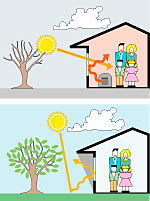 High Performance Glazing High Performance Glazing
for Replacement Windows
Heat Loss through glass can occur three basic ways:
Conduction is heat loss due to transfer from one part of a body to another part; or from one body to another body in direct contact.
Convection is the transfer of heat from one point to another within a fluid by mixing one portion of the fluid with another.
Radiation is the transfer of heat from one body to another by wave motion, without heating the space between the two bodies.
Traditional window design minimizes conduction (which mostly occurs through the frame pieces) by using non-conducting materials like wood or vinyl. Conductive heat loss through the glass itself has been effectively eliminated by using two panes of glass and separating them with an airspace (dual pane insulated glass).
Convection (between the glass surfaces through the "fluid" air) is minimized by enlarging the space between the inner and outer panes of the glass.
Radiant Heat Loss had been largely ignored (Solar Radiation, Ultra Violet radiation, and Infrared Radiation) because it passed so easily through the glass, and through the air between the glass (emissivity), and conventional ways of blocking it diminished sometimes desirable solar heat gain and visibility.
High-tech coating methods allow a process where an ultra-thin metallic coating is applied on one surface of a glass panel, or separating film, and the coating retards the passage of radiation (low emissivity) enough to improve the performance of the insulated glass unit without significant loss in solar heat gain or visibility.
Low Emissivity Coatings Retard Heat Transfer
A dual pane insulated unit with one Low "E" Glass panel and one regular panel performs equally as well as a triple pane insulated unit. In fact, a Low "E" unit blocks 85% to 90% of radiant heat, and improves the overall performance of a standard dual pane unit by as much as 55%!
There are two processes that deposit the coating on the glass. Sprayed-on Soft Coat (Sputtered Coating) has a higher effectiveness on blocking radiant heat (up to 90%), but can reduce visible light, and has to have extreme care when touched or handled due to the sensitivity of the coating.
Fused-on Hard Coat (Pyrolytic Coating) has a 5% lower effect on radiant heat (85%), but on average lets in more visible light than soft coat, and it requires less handling care since it is as hard as the glass itself. |